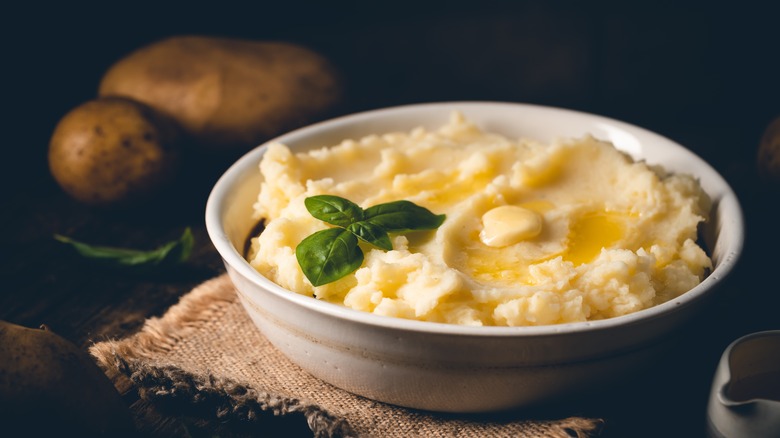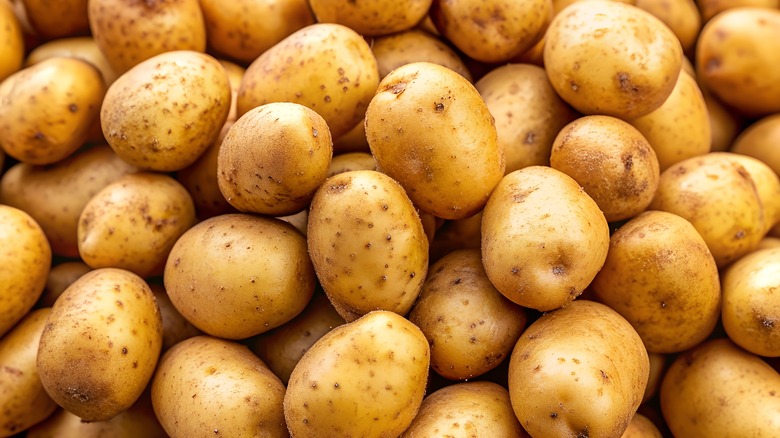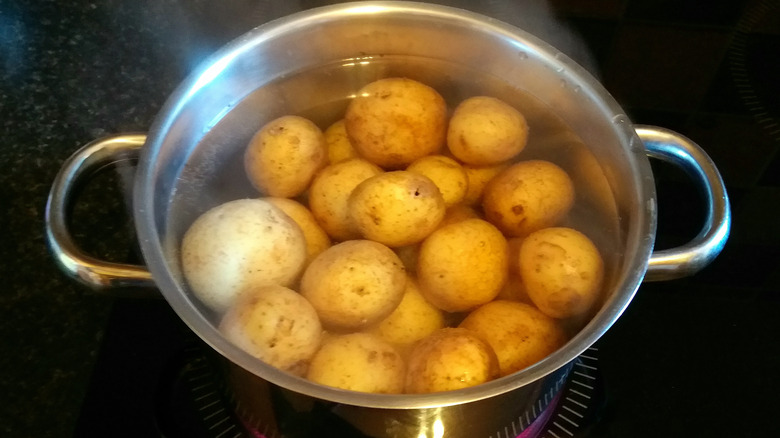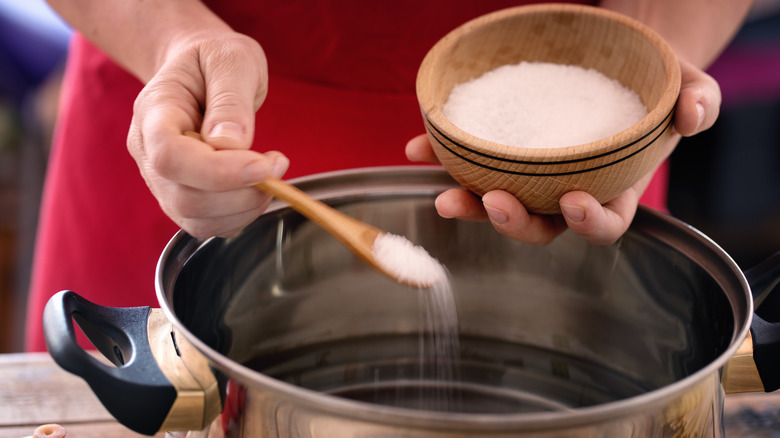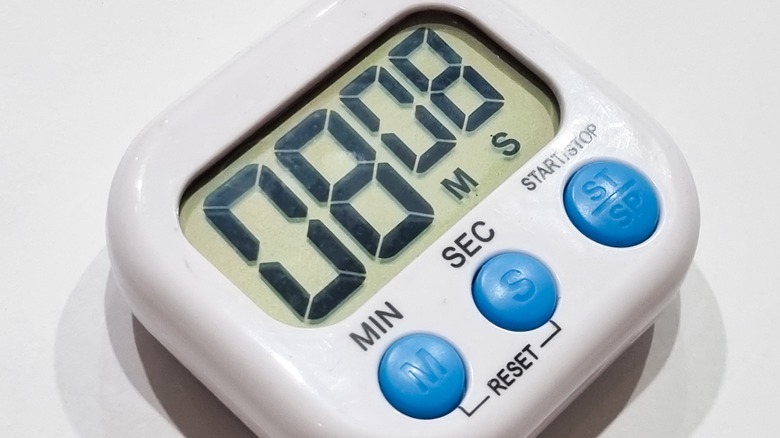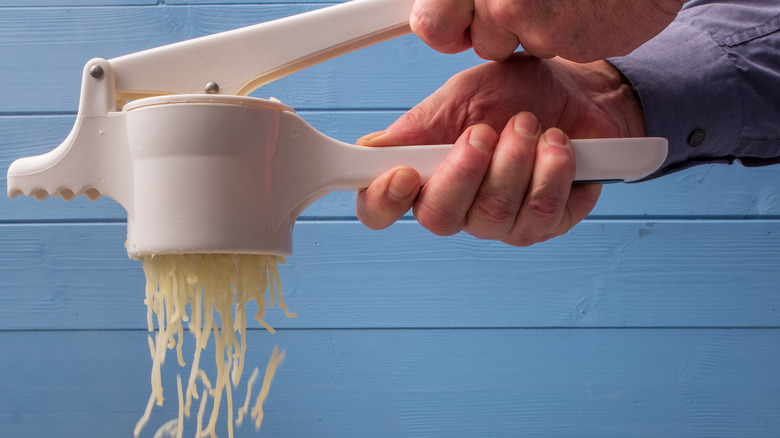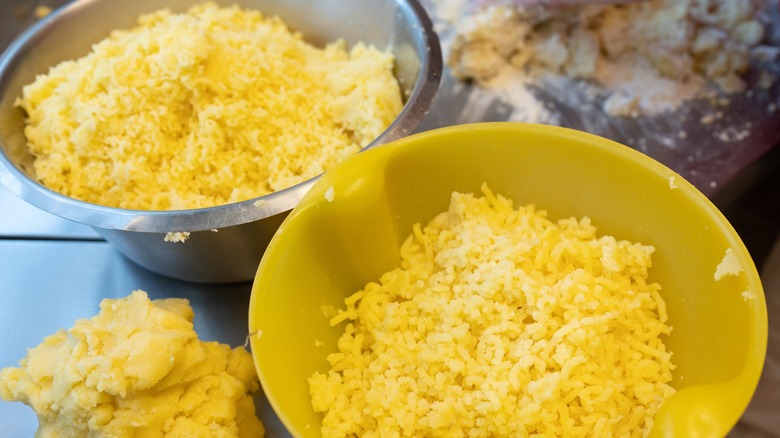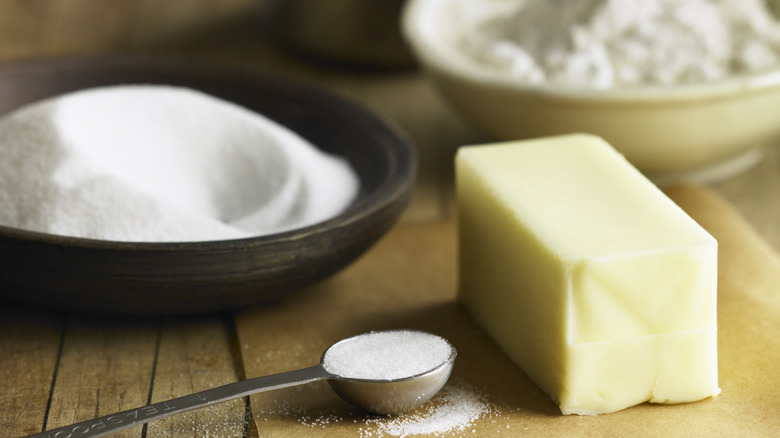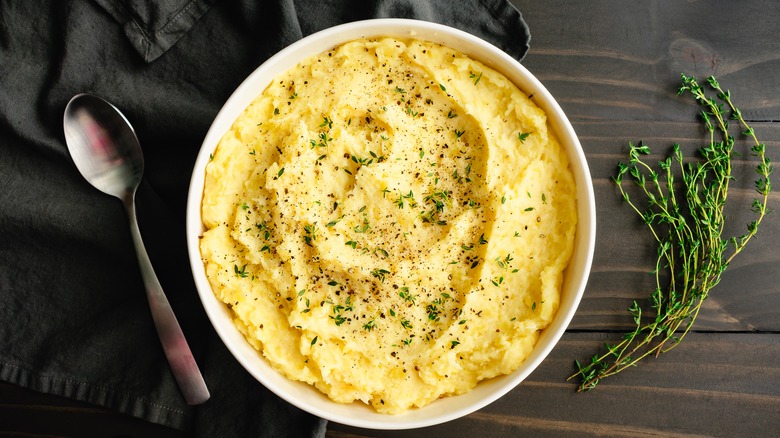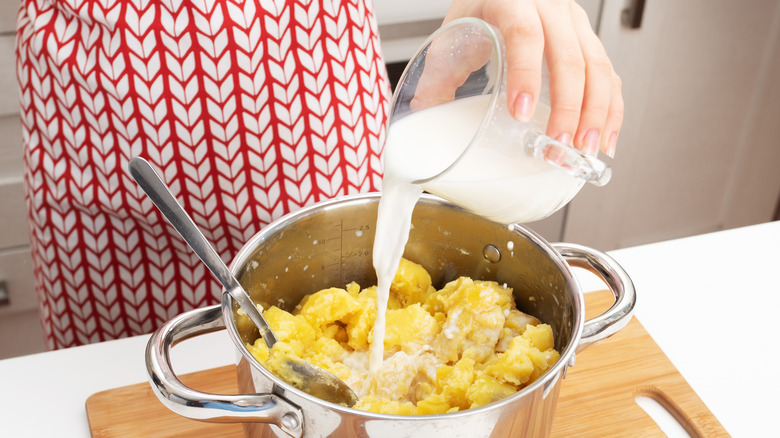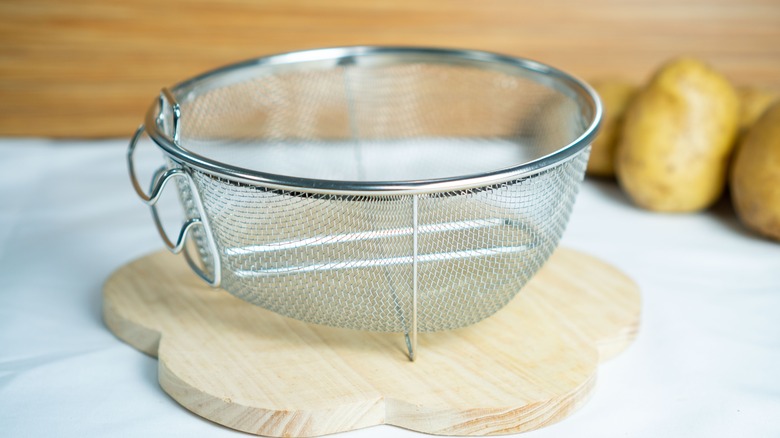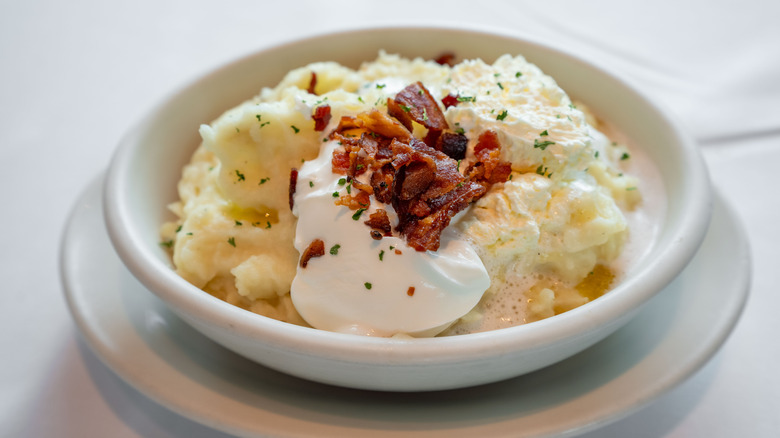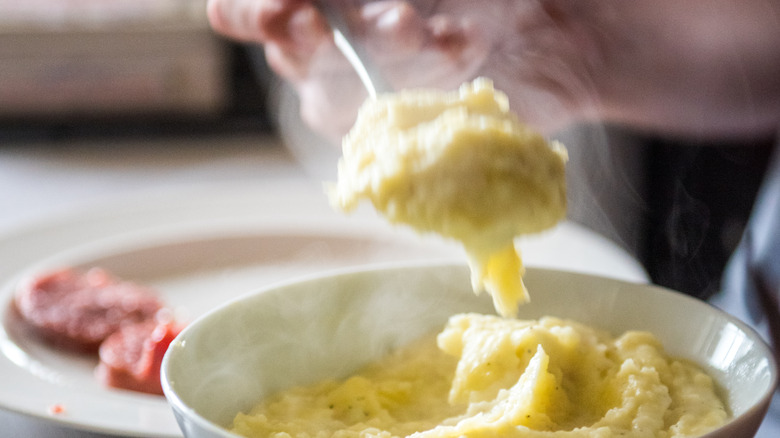Experts Reveal Why Restaurant Mashed Potatoes Always Taste Better Than Homemade
Making a batch of mashed potatoes doesn't seem all that challenging. All you need to do is boil potatoes, mash them, and mix in some butter, milk, and seasoning. However, for many of us, a simple homemade recipe never measures up to the decadently rich and creamy mashed potatoes you get at a quality restaurant. Obviously, restaurants have professional chefs working their magic behind the scenes which leads to super tasty results, but the dish doesn't have to be so elusive, does it?
To uncover some of the secrets behind why restaurant mashed potatoes always taste better, I consulted several experts who have ample experience perfecting the recipe, and they weren't shy with the tips. Ashley Schuering, an ex-line cook and the blogger behind Confessions of a Grocery Addict had lots to say on the matter, as did Jessica Randhawa, Owner & Head Chef of The Forked Spoon. In addition to these chefs, I also got some helpful insights from Lisa Lotts, the woman behind the highly acclaimed food blog Garlic and Zest, and Allie Hagerty, the Food Blogger and Recipe Creator behind Seasoned and Salted.
If you've ever asked yourself, why do my mashed potatoes suck? The information provided by these experts will certainly turn things around. Even if you think your mashed potatoes aren't bad, with a bit of help from the pros, you should be able to whip up a batch of drool-worthy mashed potatoes any restaurant would be happy to serve.
Restaurants know the type of potato you mash matters
First things first, the type of potato you use to make mashed potatoes makes a huge difference. Sure, you can mash any type of potato you want, but one of the reasons restaurant mashed potatoes are always so tasty is that they know what types of spuds are best for mashed potatoes and which ones to avoid.
Jessica Randhawa agrees: "One key reason restaurant mashed potatoes often taste better is the type of potatoes used." She notes that in general, chefs like to select potatoes with a high starch content, like Russets or Yukon Golds, because they lead to a fluffier textured mash. She also said, "These varieties absorb butter and cream more effectively, leading to richer and more flavorful mashed potatoes."
Expert Ashley Schuering also agrees. She told me that Yukon Gold potatoes give you a nice balance of starchy and waxy qualities. However, she also said that starchy varieties like Russet potatoes are her favorite for achieving the "über-creamy results you'd find at a restaurant." As you can see, there's a bit of wiggle room on the type of potato you use, especially since there are different preferences for thick versus fluffy mashed potatoes, but Schuering recommends avoiding "super waxy varieties like red potatoes, as they have a tendency to become gluey."
Restaurants boil potatoes with the skin on to prevent excess moisture
Many home chefs think peeling and dicing their potatoes before boiling is an essential first step when making mashed potatoes. However, our experts tend to disagree. Lisa Lotts told me, "Rather than peeling, chopping, and boiling the potatoes, which can add excess moisture, chefs boil them whole and unpeeled." This may sound a bit strange to some of us, but it also makes perfect sense regarding eliminating excess moisture.
Ashley Schuering agrees that boiling potatoes in their skins is ideal: "Even if you don't want to keep the skins on for mashing, boiling your potatoes in the skin is important, especially for starchier varieties." When you do this, it prevents them from becoming waterlogged. It also helps the potatoes retain some of their flavor and nutrients so they taste better in the end. If you are thinking, won't peeling hot potatoes after they come out of boiling water be tricky? Schuering says, "Don't worry, there'll be a snap to slip off when they are done cooking." That is of course, if you don't want any skins in your mashed potatoes.
Restaurants always salt the water they boil potatoes in
Most people know that adding salt to boiling water is a fantastic way to add flavor to pasta. What we might not know though is that the same can be said for potatoes you plan on mashing. As Ashley Schuering said, "You only get one shot to infuse the potatoes themselves with seasoning," and salt in the water is the key. She recommends aggressively salting your cooking water and notes, "It should taste obviously salty."
Jessica Randhawa confirmed what Schuering told me by saying, "Restaurants salt their water when boiling potatoes, which enhances their overall flavor from the inside out." At home, many cooks simply overlook this step and it is one of the many reasons restaurant mashed potatoes wind up tasting better. Lucky us, this is super easy to avoid, all you need to do is generously salt your cooking water once it starts boiling, and before you add the potatoes.
Boiling potatoes for the correct amount of time is essential
Once your potatoes are boiling, the next crucial detail you need to pay attention to is the length of time they spend in the water. Restaurants have a keen eye for noticing when potatoes are perfectly textured and cooked, and make sure to remove them at the right time.
Ashley Schuering told me that starchy potato varieties "become pretty mealy if you overcook them." To avoid this, "you want to drain the potatoes from the boiling water when they are fork-tender." On the other end of the spectrum, Lisa Lotts noted that "Under-cooking the potatoes can be a fatal flaw. If they're not cooked through, they'll be lumpy, and no amount of beating will make them smooth." She went on to say that restaurant chefs "ensure that their spuds are cooked by testing them with a sharp knife inserted into the center of a potato–if the potato slips off the blade, they're done."
This may seem simple enough, but learning when your potatoes are ready to come out of the water may take a few tries to get right. Still, when you manage to pull it off, you will be one step closer to achieving the ideal texture for mashed potatoes.
Restaurants know that a potato ricer is the key to achieving a super creamy texture
There are several helpful tools for mashing potatoes, like a hand mixer, a mashing wand, and more. They all work pretty well, but restaurants know that nothing compares to a potato ricer when making this tasty dish. Unlike other tools, it leads to super consistent, creamy results. If you like an ultra-smooth mash devoid of any lumps, you should be using a potato ricer, too.
Ashley Schuering admitted that using a potato ricer "might seem fussy, but it helps to break down the potatoes into rice size granules, rupturing the cells only once as they pass through." As a result, a good amount of air is incorporated without having to overwork them, "which can cause potatoes to become gummy."
Lisa Lotts confirmed the tool you use to mash potatoes really makes a difference: "Many home cooks miss the mark texture-wise when they use a hand mixer to blend the potatoes. Unfortunately, they usually over-beat the tubers, making them gluey and unappetizing." Chefs, on the other hand, "skip the hand mixers and opt for more elbow grease, such as a food mill fitted with the finest grate setting or a potato ricer with the finest disc available." Both of these tools keep potatoes light and fluffy when mashing and help prevent a gluey texture, which is obviously something we all want to avoid.
Restaurants mash potatoes while they are still hot
Interestingly enough, the temperature of your potatoes also matters when it comes time to mash and it's best to mash them when they are still hot from the boiling water. Expert Lisa Lotts stressed that you don't want to let them cool down because, "Mashing hot potatoes encourages excess steam (i.e., liquid) to escape, making for fluffier spuds." So, even if you are working on cooking other dishes, your potatoes should become a priority when they come out of the boiling water.
Even if you boil your potatoes with the skins on and mash them when they are hot, they still might be a bit too moist for restaurant standards. When this happens they use a quick and easy trick to dry them out before moving forward. Ashley Schuering told me that you can "place the potatoes back over medium-low heat and use a wooden spoon to mix them and dry them out." That way, you make more space for the other ingredients you are going to add and ensure the potatoes will soak up enough milk and butter to lead to a rich, creamy texture and taste.
Restaurants don't hesitate to use lots of fat and salt
When making mashed potatoes at home, many of us underestimate the amount of butter and salt needed to make them taste as yummy as the ones you order when you are dining out. "Restaurant chefs don't make mashed potatoes with the same eye to "health and restraint" that many home cooks do. Consequently, the flavors and textures are bound to be smoother, silkier, and richer than spuds made at home," said Lisa Lotts.
Ashley Schuering went so far as to say, "The primary reason restaurant mashies taste so darn good is they use plenty of butter, cream or milk, and seasoning." However, when we are at home, we tend to hold back a bit more than a professional chef does. Take it from her though, and "don't be shy with the fat & salt!" According to both Schuering and Lotts, a 2-to-1 ratio of potatoes to butter is the golden standard for restaurant mashed potatoes. For the average home cook, this sounds like a ton of butter, and honestly, it is. Even so, restaurants know the key to an ultra-smooth and creamy mash can only be achieved by refusing to skimp on the butter.
A generous amount of salt is also key to achieving the drool-worthy taste of restaurant mashed potatoes. "Restaurants use three to four times more salt than most conventional home cooks would use," said Lotts.
Professional chefs are experts at seasoning to taste
As we now know, salt is an essential part of mashed potatoes and we shouldn't hold back. Even so, you don't want to go too far with it or other seasonings, so it is imperative you taste your food as you go and add ingredients slowly. That way, you can make minor adjustments as needed until you reach perfection. This method of seasoning to taste is practically second nature for professional chefs, but for less-experienced home cooks, finding the ideal balance of flavors is not as intuitive. We have to work at it a bit more, but it can be done.
According to Allie Hagerty, "Restaurant chefs season in layers. This ensures the seasoning is balanced and fully absorbed, creating a well-rounded flavor." Seems easy enough, but it isn't so clear cut. Ashley Schuering shared an interesting approach that could be quite helpful for new cooks: "I read an article once that totally changed my approach —the idea was to keep salting a small amount of a dish on the side, tasting as you go. The ideal sweet spot is *right* before it tips over into over-salted territory." She also noted it may take some practice, but it'll make a huge difference when you get it right.
Restaurants take their milk seriously
When I make mashed potatoes at home, I typically reach for whatever kind of milk I have in the fridge. It doesn't matter if it's skim, whole, or heavy cream, I'll use whatever, and many home cooks do the same. However, restaurant chefs never fall prey to this practice. In fact, they take the type of milk they use very seriously. From the fat content to the temperature, they pay attention to the details, and that's one of the many reasons their mashed potatoes always taste so darn good.
According to Lisa Lotts, "Restaurants use cream–sometimes heavy- to give mashed potatoes a silky, rich, velvety mouthfeel." With other lower-fat milks, this just isn't attainable. She revealed that another chef secret is to heat the milk before adding it to the butter because it mixes in easier. Plus, "Less stirring means less starch is released, and the potatoes will be fluffy, not gluey," said Lotts. Of course, adding hot milk also helps to keep the mash as warm as possible until it is ready to serve.
Expert Allie Hagerty also noted, "Chefs adjust the consistency meticulously, adding just enough liquid for smooth, soft potatoes that still hold their shape." Try to do this at home, heat your milk, and use something with a high-fat content like half-and-half or heavy cream, and you'll be glad you did.
Some restaurants push their mashed potatoes through a fine mesh strainer
Another trick some restaurants use for their mashed potatoes is giving them a second pass through a fine mesh strainer. When this technique is utilized, it leads to the smoothest mashed potatoes possible. Ashley Schuering had this to say on the matter: "While it is completely optional, you are welcome to press your buttered and seasoned mashies through a fine mesh strainer or sieve once more before serving for an extra ethereal quality." Ethereal mashed potatoes? Yes, please.
If you don't have a sieve or fine mesh strainer, you can also use a food processor to achieve similar results. Food processors are used to make all kinds of purees and potatoes just so happen to be one of them. Regardless of the tool you use, this is the kind of mashed potato you find in a fine dining restaurant. You know, the kind of place where they call the dish pommes purée. While there are many different styles of mashed potatoes, pommes purée is by far one of the most decadent, and delicious for that matter. No matter what you call it though, don't sleep on this sneaky tip if you love an unbelievably smooth, rich, and creamy batch of mashed potatoes.
Some restaurant recipes include super tasty additional ingredients
We all know the basic ingredients needed for mashed potatoes are butter, salt, milk or cream, and of course, potatoes. You don't have to stop there, though, and many restaurants don't. Professional chefs often continue layering in flavor with other tasty ingredients like cheese, olive oil, garlic, and much more.
As you can probably imagine, "Adding luxurious extras like cream cheese, sour cream, or even mascarpone can elevate the flavor and texture, making the mashed potatoes extra creamy and tangy," said owner Jessica Randhawa. She noted that restaurants use these additional ingredients generously, while home cooks may find them too indulgent.
In addition to creamy elements, restaurant chefs often add a range of other seasonings. According to Allie Hagerty, "Chefs might mix in roasted garlic, chives, or even rosemary for a flavor boost. These fresh, well-balanced additions add complexity without overpowering the potatoes." She also recommends a touch of white pepper, which is subtle, but "adds a professional finish to the flavor." In addition, she told me chefs achieve an aromatic touch by drizzling high-quality olive or infused oil over the top.
Lisa Lotts also weighed in on the matter: "Chefs are known for outrageous and over-the-top ingredients, which is what transforms their mashed spuds into a gustatory adventure." She said anything from truffle oil to lobster meat to foie gras folded into the puree elevates the dish.
Serving mashed potatoes steaming hot makes a big difference
Finally, once you are done making your mashed potatoes it's essential that you serve them while they are still steaming hot. If not, much of your hard work will go to waste. Restaurants know the importance of serving piping hot mashed potatoes and strive to do so with every single portion.
Considering all we have learned so far, we know restaurants are masters at paying attention to details, and with mashed potatoes, this includes the serving temperature. According to Jessica Randhawa, "Restaurants serve their mashed potatoes hot, usually steamed or kept in a warm oven until served, which can make a big difference in taste perception."
Expert Allie Hagerty also told me allowing mashed potatoes to rest is beneficial: "Believe it or not, letting mashed potatoes sit for a few minutes allows the flavors to meld." This might seem counterintuitive since we know it's best to enjoy them steaming hot, but she went on to say, "Restaurants often make them a bit in advance and keep them warm, which deepens the flavor."
As you can see, there are many mistakes to avoid when making mashed potatoes, at least if you're trying to achieve restaurant-worthy status. Thanks to all of the helpful insights provided by our experts, all you need now is a little practice and your homemade mashed potatoes will be decadently creamy and delicious in no time at all.

